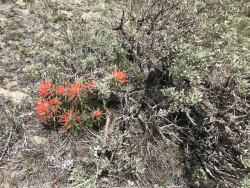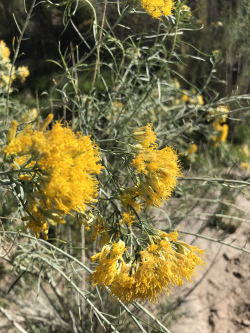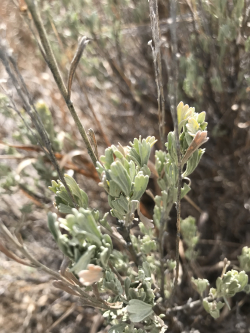
Courtesy and Copyright © by Shannon Rhodes, photographer
Often, when we see indian paintbrush, whether we’re in Utah’s deserts up in elevation through subalpine meadows, we also see sagebrush. They are both native to Utah. In fact, some species of indian paintbrush are root-parasites for sagebrush, intertwining roots to access water and nutrients because they lack small hairs on their own.

Courtesy and Copyright © by Shannon Rhodes, photographer
Mae Timbimboo Parry, once a recordkeeper of the Northwestern Band of the Shoshone, sketched how to identify sagebrush in much the same way. In his appendix of “The Bear River Massacre: A Shoshone History,” Darren Parry shares his grandmother’s handwritten field notes about sagebrush, indicating its use in tea and purifying ceremonies. I was surprised at first that she did not include indian paintbrush in the list of plants until I realized that willow, wildrose, sego lily, and sunflower all had practical uses beyond their beauty. Some have said that the sagebrush is the backbone of the West, and I would add that indian paintbrush adds a splash of color.

Courtesy and Copyright © by Shannon Rhodes, photographer
I’m Shannon Rhodes, and I’m wild about Utah.
Credits:
Images: Courtesy & Copyright © Shannon Rhodes, Photographer
Audio: Courtesy & © Kevin Colver https://wildstore.wildsanctuary.com/
Text: Shannon Rhodes, Edith Bowen Laboratory School, Utah State University https://edithbowen.usu.edu/
Additional Reading Links: Shannon Rhodes
Additional Reading:
Alpine Nature Center. Is It Rabbitbrush or Is It Sagebrush? https://www.alpinenaturecenter.org/rabbit-vs-sage.html
de Paola, Tomie. The Legend of the Indian Paintbrush. Penguin Putnam Books for Young Readers. 1988. https://www.tomie.com/https://www.audubon.org/news/celebrating-sagebrush-wests-most-important-native-plant
Johnson, Jeff. Head of Sinbad Pictographs in San Rafael Swell. https://thetrekplanner.com/head-of-sinbad-pictographs-san-rafael-swell-utah/
Larese-Casanova, Mark. Desert Plants Field Book. Utah Master Naturalist. https://digitalcommons.usu.edu/cgi/viewcontent.cgi?article=1911&context=wats_facpub
Mozdy, Michael. Bold Figures, Blurred History: The Great Gallery in Horseshoe Canyon. October 2, 2016. https://nhmu.utah.edu/blog/2016/09/29/bold-figures-blurred-history-great-gallery-horseshoe-canyon
Miller, Pam, and Blaine Miller. Rock Art in Utah. https://www.uen.org/utah_history_encyclopedia/r/ROCK_ART.shtml
Parry, Darren. The Bear River Massacre: A Shoshone History. https://heritageandarts.utah.gov/the-bear-river-massacre-a-shoshone-history-a-conversation-with-darren-parry/
Repandshek, Kurt. Traces of a Lost People. The Smithsonian Magazine. March 2005. https://www.smithsonianmag.com/arts-culture/traces-of-a-lost-people-84026156/
Scotter, Troy, and Nina Bowen. The Rock Art of Utah. Utah Rock Art Research Association. May 13, 2020. https://urara.wildapricot.org/page-18203
Strand, Holly. Woody Plants of Utah. Wild About Utah, December 15, 2011. https://wildaboututah.org/tag/rabbitbrush/
Strand, Holly. Sagebrush. Wild About Utah, January 14, 2009. https://wildaboututah.org/sagebrush/
Susec, David. The Barrier Canyon Rock Art Style. The B.C.S. Project. https://www.bcsproject.org/barrierstyle.html
U.S. National Park Service. Seeing Rock Markings in a Whole New Way. https://www.nps.gov/articles/cany-rock-markings-photo.htm
Wampler, Fred. Paintbrush and Sagebrush. University of Mary Washington Gallery. https://www.umwgalleries.org/paintbrush-and-sagebrush/
Young, Lauren. Saving the American West’s Sagebrush Sea. May 19, 2001. https://www.sciencefriday.com/articles/saving-sagebrush/
